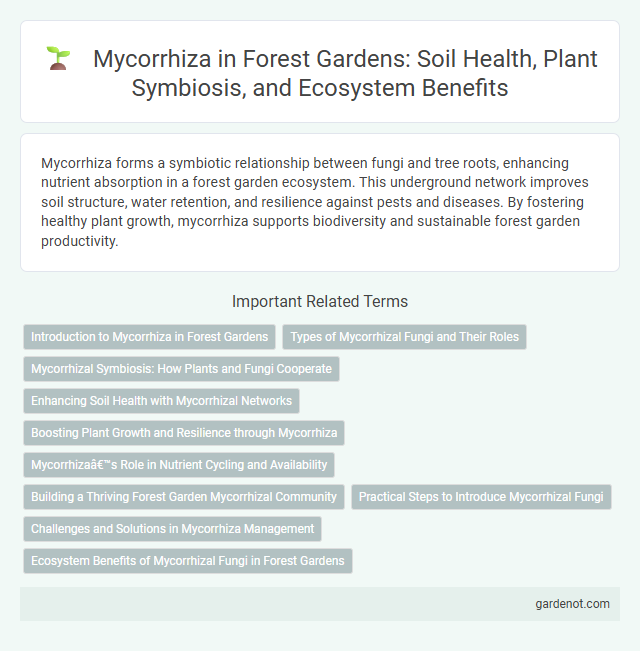Mycorrhiza forms a symbiotic relationship between fungi and tree roots, enhancing nutrient absorption in a forest garden ecosystem. This underground network improves soil structure, water retention, and resilience against pests and diseases. By fostering healthy plant growth, mycorrhiza supports biodiversity and sustainable forest garden productivity.
Introduction to Mycorrhiza in Forest Gardens
Mycorrhiza is a symbiotic association between fungi and plant roots, crucial for nutrient exchange in forest gardens. This mutualistic relationship enhances water absorption and nutrient uptake, especially phosphorus, improving plant health and resilience. Integrating mycorrhizal fungi supports sustainable growth and biodiversity within forest garden ecosystems.
Types of Mycorrhizal Fungi and Their Roles
Ectomycorrhizal fungi form symbiotic relationships with tree roots, enhancing nutrient and water absorption, especially in forest garden species like oaks and pines. Arbuscular mycorrhizal fungi penetrate root cells of herbaceous plants, improving phosphorus uptake and soil structure vital for understory crops. Ericoid mycorrhizal fungi support ericaceous plants by aiding nutrient access in acidic soils, contributing to diverse plant health and productivity in forest garden ecosystems.
Mycorrhizal Symbiosis: How Plants and Fungi Cooperate
Mycorrhizal symbiosis forms a crucial partnership where fungi colonize plant roots, enhancing nutrient and water absorption while receiving carbohydrates produced by the plant. This mutualistic relationship improves soil structure, increases plant resistance to pathogens, and boosts overall forest garden productivity. Research shows mycorrhizal networks facilitate communication and resource sharing among plants, creating a more resilient and interconnected ecosystem.
Enhancing Soil Health with Mycorrhizal Networks
Mycorrhizal networks form symbiotic relationships with forest garden plants, significantly enhancing soil health by increasing nutrient and water absorption. These fungal networks improve soil structure and microbial diversity, promoting resilient plant growth and reducing the need for chemical fertilizers. Leveraging mycorrhizae in forest gardens accelerates ecosystem restoration and boosts long-term soil fertility.
Boosting Plant Growth and Resilience through Mycorrhiza
Mycorrhiza enhances plant growth by forming symbiotic relationships with root systems, improving nutrient and water absorption in forest gardens. This fungal association strengthens plants' resilience against drought, soil pathogens, and environmental stressors by enhancing soil structure and microbial activity. Leveraging mycorrhizal networks promotes healthier, more productive forest garden ecosystems with increased biodiversity and sustainability.
Mycorrhiza’s Role in Nutrient Cycling and Availability
Mycorrhizae enhance nutrient cycling by forming symbiotic associations with plant roots, facilitating the uptake of essential nutrients like phosphorus and nitrogen from the soil. These fungal networks increase nutrient availability by decomposing organic matter and transferring minerals directly to host plants, improving soil fertility in forest gardens. Their extensive hyphal networks also promote soil structure and moisture retention, supporting overall ecosystem health and plant productivity.
Building a Thriving Forest Garden Mycorrhizal Community
Mycorrhizae form symbiotic relationships with forest garden plants, enhancing nutrient uptake and soil structure crucial for a thriving ecosystem. These fungi improve phosphorus and nitrogen absorption, promote root growth, and increase plant resilience against diseases and environmental stresses. Establishing a diverse mycorrhizal community supports sustainable growth and long-term productivity in forest gardens.
Practical Steps to Introduce Mycorrhizal Fungi
To introduce mycorrhizal fungi in a forest garden, begin by sourcing high-quality mycorrhizal inoculants specific to the tree species present. Apply the inoculant directly to root zones during planting or around existing roots by lightly disturbing the soil to enhance fungal-root contact. Maintain soil health with organic mulches and avoid excessive chemical fertilizers to support fungal colonization and symbiotic growth.
Challenges and Solutions in Mycorrhiza Management
Managing mycorrhiza in forest gardens faces challenges such as soil disturbance, nutrient imbalances, and competition from non-mycorrhizal plants that hinder fungal colonization. Solutions include promoting minimal tillage to preserve fungal networks, applying organic amendments that support symbiotic fungi, and selecting compatible plant species to enhance mutualistic relationships. Implementing crop rotation and avoiding excessive fertilizer use further sustain healthy mycorrhizal communities critical for nutrient cycling and plant growth.
Ecosystem Benefits of Mycorrhizal Fungi in Forest Gardens
Mycorrhizal fungi form symbiotic relationships with tree roots in forest gardens, enhancing nutrient uptake and improving soil structure. These fungi increase plant resilience to drought and disease by facilitating better water absorption and providing access to essential minerals like phosphorus. The extensive mycelial networks also promote biodiversity by connecting different plant species and supporting overall ecosystem health.
Mycorrhiza Infographic

 gardenot.com
gardenot.com